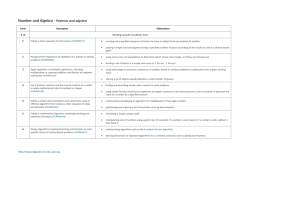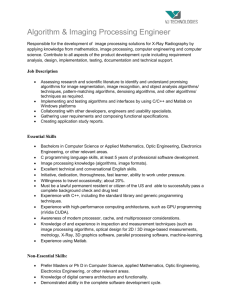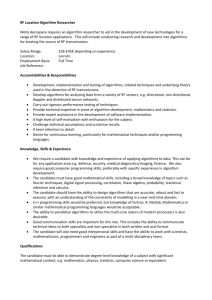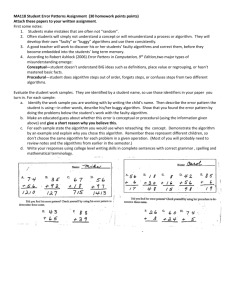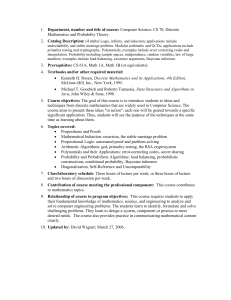A reference framework for teaching the standard
advertisement
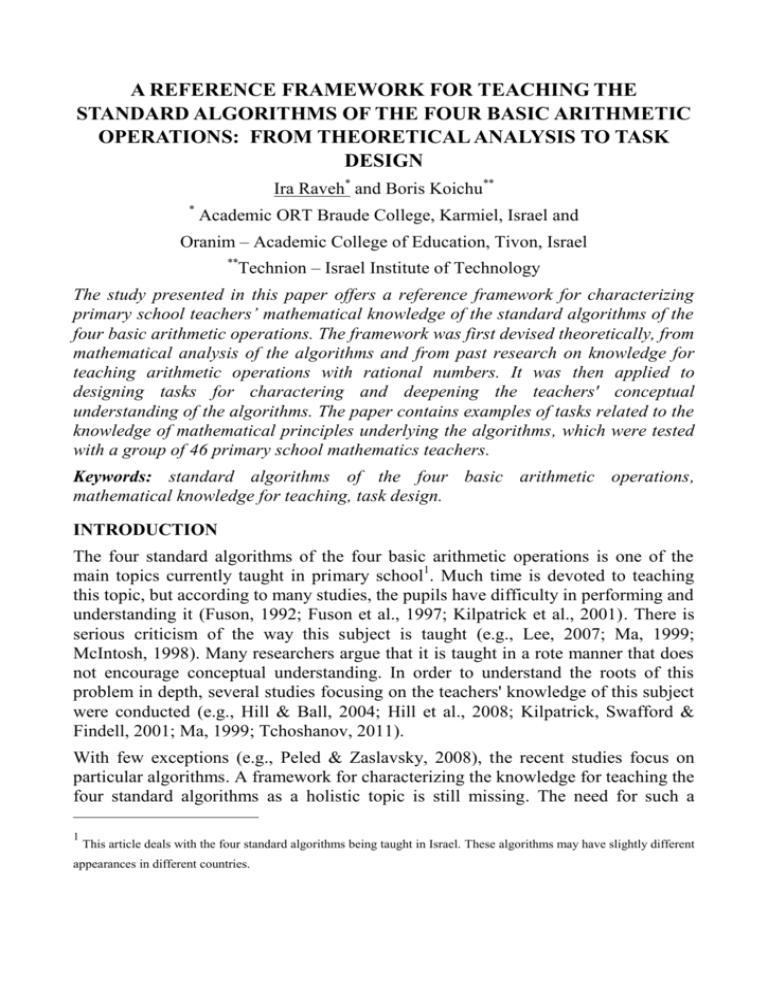
A REFERENCE FRAMEWORK FOR TEACHING THE STANDARD ALGORITHMS OF THE FOUR BASIC ARITHMETIC OPERATIONS: FROM THEORETICAL ANALYSIS TO TASK DESIGN Ira Raveh* and Boris Koichu** * Academic ORT Braude College, Karmiel, Israel and Oranim – Academic College of Education, Tivon, Israel ** Technion – Israel Institute of Technology The study presented in this paper offers a reference framework for characterizing primary school teachers’ mathematical knowledge of the standard algorithms of the four basic arithmetic operations. The framework was first devised theoretically, from mathematical analysis of the algorithms and from past research on knowledge for teaching arithmetic operations with rational numbers. It was then applied to designing tasks for charactering and deepening the teachers' conceptual understanding of the algorithms. The paper contains examples of tasks related to the knowledge of mathematical principles underlying the algorithms, which were tested with a group of 46 primary school mathematics teachers. Keywords: standard algorithms of the four basic arithmetic operations, mathematical knowledge for teaching, task design. INTRODUCTION The four standard algorithms of the four basic arithmetic operations is one of the main topics currently taught in primary school1. Much time is devoted to teaching this topic, but according to many studies, the pupils have difficulty in performing and understanding it (Fuson, 1992; Fuson et al., 1997; Kilpatrick et al., 2001). There is serious criticism of the way this subject is taught (e.g., Lee, 2007; Ma, 1999; McIntosh, 1998). Many researchers argue that it is taught in a rote manner that does not encourage conceptual understanding. In order to understand the roots of this problem in depth, several studies focusing on the teachers' knowledge of this subject were conducted (e.g., Hill & Ball, 2004; Hill et al., 2008; Kilpatrick, Swafford & Findell, 2001; Ma, 1999; Tchoshanov, 2011). With few exceptions (e.g., Peled & Zaslavsky, 2008), the recent studies focus on particular algorithms. A framework for characterizing the knowledge for teaching the four standard algorithms as a holistic topic is still missing. The need for such a 1 This article deals with the four standard algorithms being taught in Israel. These algorithms may have slightly different appearances in different countries. framework manifests itself due to the broadly recognized importance of emphasizing the connectedness of mathematics (e.g., NCTM, 2000). In addition, and in line with research on other mathematical topics, such a framework is needed for systematic design of mathematical tasks with the potential to characterize and promote the teachers' knowledge of the subject. The present study aims at fulfilling this gap2. Specifically, the goal of the study is to identify, first theoretically, the components of mathematical knowledge for teaching the standard algorithms of the four basic arithmetic operations, and then to empirically examine the feasibility of the framework by applying it to the design of tasks having the potential to capture variations in the teachers' knowledge. In the next section we present and theoretically justify the framework. This is followed by examples of tasks related to one of the framework's components, the knowledge of mathematical principles underlying the algorithms. The article is concluded by remarks on applicability of the framework for research and practice. REFERENCE FRAMEWORK The framework presented in Table 1 is devised based on juxtaposition of two sources: (1) past studies on the knowledge for teaching the basic arithmetic operations with rational numbers, and (2) analysis of the algorithms in terms of the underlying mathematical principles. Component PK Procedural Knowledge Knowledge of mathematical Principles underlying each algorithm: place-value, number regrouping and distributive law KS Knowledge of Similarity between different algorithms based on the common underlying principles KR Knowledge of different Representations of each algorithm and connections between them KP 2 Operative criteria for component examination 1. Demonstrated knowledge of the algorithms' steps 2. Performing correct computations 1. Recognizing mathematical principles, which are violated in students' incorrect performance 2. Explaining the stages of the algorithms using appropriate mathematical principles 3. Recognizing mathematical principles underlying different representation of the algorithms 1. Recognizing common principles underlying different algorithms 2. Classification mistakes in the use of different algorithms by pointing out the common mathematical principles violated "Translating" standard, vertical, algorithms to horizontal representations The paper is based on the PhD research of the first-named author conducted in the Technion under the supervision of the second-named author, Prof. Orit Zaslavsky and Dr. Irit Peled. Table 1: Reference framework for teaching the four elementary algorithms Noticeably, the first component corresponds to the notion of procedural understanding, and the next three – to conceptual understanding, as defined by Skemp (1987). Procedural Knowledge (PK) refers to one's ability to accurately perform the algorithms. This component is not unique for teachers' knowledge. Ball, Hill and Bass (2005) claim that being able to perform the algorithms correctly is essential for teaching, but also insufficient. Knowledge of mathematical Principles underlying each algorithm (KP) component is included in the framework because, mathematically speaking, the algorithms work based on certain mathematical laws, and it is reasonable to assume that knowledge of these laws is an important part of conceptual understanding the topic. Peled and Zaslavsky (2008) classified this type of knowledge as "local connections between procedures and conceptual knowledge" (p. 28). The principles for the framework were chosen as follows. First, many researchers assert the role of the place value principle in the addition and subtraction algorithms (Ball, Hill & Bass, 2005; Kilpatrick, Swafford & Findell, 2001; Fuson, 1992; Ma, 1999; Thanheiser, 2010); some mention the principle as underlying also the multiplication (Ma, 1999; Kilpatrick, Swafford & Findell, 2001) and the division (Kilpatrick, Swafford & Findell, 2001) algorithms. Second, several researchers point out that the number regrouping principle is reflected in addition and subtraction algorithms (Kilpatrick, Swafford & Findell, 2001; Fuson, 1992; Ma, 1999), and it is possible to show that this principle is also involved in the multiplication and division algorithms. Third, Ma (1999) recognizes the distributive law as underlying the multiplication algorithm, and it is not difficult to see that it also underlies the division algorithm. In sum, the first two principles underlie all the four algorithms, and the third one – the multiplication and division algorithms. Knowledge of Similarity (KS) between different algorithms based on the common underlying principles was considered by Peled and Zaslavsky (2008) as a kind of meta-knowledge "about a procedure which includes global aspects underlying a specific procedure or common to a number of procedures" (p. 31). They explored the iterative structure of the standard algorithms as an example of such meta-knowledge and argued that it may emerge in learners based on noticing the iterative structure of each algorithm. In the proposed framework, we choose to focus on the similarity between the algorithms at the level of the above three mathematical principles. Consequently, there is a sort of hierarchy between the KP and KS components: the KP component is necessary (though not sufficient) for KS. Our focus on the mathematical principles in the KS component is based on the twofold argument, as follows. On one hand, a person who studied each algorithm separately and observed that a particular principle repeatedly appears, may use this observation as a semantic tool for expressing in-depth similarity between the algorithms (cf. Peled & Zaslavsky, 2008, for a compatible argument). On the other hand, a person who learned that the same principle underlies several algorithms may use this knowledge in order to unpack how the principle works in each algorithm. Knowledge of different Representations (KR) of each algorithm and connections between them component is included in the framework because many researchers accent the importance of knowledge of different representations and models of the subject taught for its conceptual understanding (e.g., Ball, Hill & Bass, 2005; Davis & Simmt, 2006; Hiebert & Carpenter, 1992; Leikin & Levav-Waynberg, 2007; Ma, 1999). Among various representations and models of the four standard algorithms, we choose to focus on translating from the standard, vertical, representation of the algorithms to their horizontal representations. This is because for all four algorithms the translation process is rich with the opportunities to unpack the procedures' steps and reveal how the aforementioned mathematical principles work. Each knowledge component may be manifested at different levels of depth. The operational criteria for identifying the teachers' knowledge on a conceptual level are presented in Table 1. A person may also possess only rote-level knowledge of the algorithms. In terms of our framework, the rote level of knowledge is manifested when a person, who was encouraged to explicitly use his or her knowledge of the underlying mathematical principles, exposed only the knowledge of the technicalcomputational aspects in discourse or performance. These two levels of knowledge are exemplified in the next section. CHARACTERIZING THE COMPONENTS OF KNOWLEDGE BY MEANS OF TASKS In this section we show how the framework can be applied to the design of tasks having the potential to reveal one's level of knowledge of the algorithms. Due to space constraints, we decided to focus only on the KP component. Three tasks that correspond to three operational criteria characterizing the KP component of knowledge are presented below. The tasks were tested in five 90-minute professional development workshops with two groups of elementary school teachers. Overall, 46 teachers participated in 10 workshops, which were conducted by the first-named author in the framework of a one-year professional development course. The teacherparticipants possessed at least B.Ed. degree, had already taught mathematics (among other subjects) in elementary school and wished to be certified as elementary school mathematics teachers. The principles underlying the four algorithms were discussed with the teachers prior to exposing them to the tasks. The teachers worked on Task 1 and Task 3 in groups of two to four participants; Task 2 was given for individual work. The performance of each group on each task was audio-taped and transcribed; all the written materials were collected. Additional insight on teachers’ work on the tasks was received during individual interviews conducted after the end of the workshop’s part dealing with the standard algorithms. The two answers accompanying Task 1 and Task 2 presented below are representative of the edges of the spectrum of the answers: the first points to the rote level and the second to the conceptual level of knowledge. Two answers related to Task 3 exemplify different degrees of conceptual-level knowledge. The examples were chosen in order to demonstrate the range of variations in the teachers’ knowledge, which can be captured by the framework. Task 1: Mistaken computations The task corresponds to the first operational criteria for the KP component (see Table 1). The teachers were given a series of computations by imaginary pupils containing various violations of the place-value and regrouping principles in the four algorithms3. Four items presented in Figure 1 deal with violations of the place-value principle. For each computation, the teachers were required: (1) to explain the mistake, (2) suggest its possible reason(s), and (3) offer a suitable method to pedagogically treat it. They were asked first to discuss the above three requests, and then to put their agreed responses in writing. Note that the teachers were not instructed to necessarily use the names of the principles in their written responses, though the principles were emphasized at the beginning of the workshop. Thus, a variation inherited in the task was related to the teachers' choice of whether or not to use the (conceptual) language of the mathematical principles or to use rote language. 42 245 7555 025 4502 44 505 085 50 802 44 4085 075 4550 20 550 22 2005 52 Fig. 1: Examples of mistaken computations from Task 1 One group of teachers responded, in writing, to the multiplication item in Figure 1 as follows: Description of the mistake: The student didn’t write the numbers at the right place. Possible reasons for the mistake: The student forgot to move the numbers (the partial products) to left side. Possible method to treat the mistake: To remind the technique of the multiplication algorithm. 3 Some computations were adopted from Zaslavsky (2003) and the others were offered by the first-named author based on mathematical analysis of the algorithms Noticeably, the teachers choose not to mention the place-value principle in their response and considered only the technical aspect. They did the same with the rest of the items. Moreover, the principles were not mentioned also in the audio-taped discussion. Thus, it can be suggested that the mistaken computations were treated by the teachers in a rote manner. Another group of teachers responded to the task as follows: Description of the mistake: The student doesn’t understand the meaning of the number’s place according the place-value principle. Possible reason for the mistake: The student doesn’t understand the place-value of the number 1065 (tens) and 639 (hundreds). The student doesn’t understand the importance of adding the appropriate units at the stage of addition of the algorithm. Possible method to treat the mistake: To ask the student to estimate the product quantity: 200 300 60000 . Is it possible that 213 354 2556 ? To explain the student that 213 multiplied by 5 tens is 1056 tens, so we must to write the product at the place of tens, so at the next stage of the algorithm we can add appropriate units. In this response we can see explicit reference to the place value principle. In “possible methods to treat the mistake” the teachers suggest a series of exercises aimed at raising the pupils' awareness of the place value principle indirectly, by means of estimating the results. Such an answer can be taken as a manifestation of the teachers' conceptual-level knowledge of KP. Task 2: Unpacking the algorithms The task corresponds to the second operational criteria for the KP component (see Table 1) and concerned the multiplication and division algorithms. As to multiplication, the teachers were offered the following scenario: Imagine that you are sitting in the teachers’ room. One of your colleagues asks you to explain as specifically as you can each step of the standard multiplication algorithm while solving an exercise "435 times 28." The colleague specifically asks you to point out the mathematical principles underlying the algorithm as she is going to teach the algorithm next week and wants to be sure that she knows not only the technical part. The task was to individually write the explanation asked for by the colleague. The contrast between the responses of Teacher A and Teacher B, in terms of rote and conceptual levels of the KP component is apparent below. 550 28 5585 875 42485 Fig.2: A computation from Task 2 Teacher A (with the reference to Fig. 2): 8 multiplying by 435 3480. We write the result right beneath. 2 multiplying by 435 870. We move the result one place to the left (it’s possible to write zero as a placeholder). Finally we adding the results and get 12180. Teacher B (with reference to Fig. 2) First of all, you have to explain that we regroup 28 as 20 and 8 and multiply each part separately: 435 (20 8) . We then have to remind the distributive law in order to explain the multiplication: 435 (20 8) 8 units multiplied by 435 is 3480 units, and 2 tens multiplied by 435 are 870 tens. So we must write the results in the appropriate places. It’s the key element of the explanation. Only after understanding this properly you can continue. Finally, you have to add the partial products and pay attention to the units. In sum, the rote and conceptual level responses were observed at both Task 1 and Task 2. Note however, the following differences in task design: Task 1 addresses imaginary students and Task 2 – an imaginary colleague; Task 1 does not include explicit instruction to mention the mathematical principles underlying the algorithms and Task 2 does. Consequently, one can reasonably suggest the following. Those teachers who responded to at least one of the tasks in a conceptual manner may be characterized as those who possess conceptual-level knowledge of the KP component. Those teachers who responded to both tasks in rote manner, probably not only decided not to mention the principles in the given context, but indeed do not possess conceptual-level knowledge. Task 3: "Translating" the algorithms into horizontal representation The task corresponded to the third operational criteria for the KP component (see Table 1) and included items related to the subtraction, multiplication and division algorithms; each algorithm was dealt with in one 90-minute workshop. The task was to “translate” all the stages of the computation presented in the standard, vertical, form, into a horizontal row of transformations and justify the validity of each equality sign in the row by the aforementioned mathematical principles. The division algorithm was reserved for the last workshop, so the teachers already knew how to deal with the task in the contexts of the subtraction and multiplication algorithms. Nevertheless, 7 out of 10 groups appeared to be unable to translate the division presented in Fig. 3 and returned empty sheets. Apparently, this occurred because the task was more demanding that the previous ones: only those who possess conceptual knowledge of the division algorithm could write something in response. Two examples below suggest that groups who did respond to the task possessed the required conceptual knowledge, although to different degrees. Fig.3: A computation from Task 3 732 7770 27 -77 370 -772 One group of the teachers responded to the task as follows: Division 2473 by its parts Performance of division 2473:12=2400:12+72:12+1:12=200+6+1:12 As can be seen, the teachers translated the computation using two row transformations and used their own expressions to explain them rather than the names of the aforementioned principles. The response of another group follows. Regrouping 2473 Distributive law of division Performance of division Performance of addition 2473:12= (2400+72+1):12=2400:12+72:12+1:12=200+6+1/12=206+1/12 This group translated the vertical computation using four row transformations and explained the first two in terms of the intended mathematical principles. Based on the above written responses, follow-up interviews and a whole-group discussion, we know that the first group chose to translate the vertical computation into a horizontal form straightforwardly, by focusing on particular numbers in the vertical algorithm (i.e., 24, 72 and 1). Then when the teachers tried to explain each horizontal transformation as requested in the task, they observed that the names of the principles did not fit and used their own expressions. The second group began from recalling the relevant principles and decided how many and which transformation to write so they would fit the names of the principles. Consequently, we deem that the response of the second group reflects a higher degree of conceptual knowledge of the division algorithm, in terms of the offered framework, than that of the first one. SUMMARY AND CONTRIBUTION Ball, Hill and Bass (2005) point out the teachers' ability to unpack a mathematical subject into related sub-subjects as an important component of mathematics knowledge for teaching. In the context of the standard algorithms of the four basic arithmetic operations, such an unpacking still needs operational conceptualizing. A reference framework presented in this article offers one way of so doing. Specifically, it puts forward the mathematical principles underlying the algorithms as an overarching semantic/mathematical tool for identifying the components of knowledge needed for teaching the algorithms. Consequently, the study continues and advances the research venue started in the studies of Ball, Hill and Bass (2005); Ma (1999) and Peled and Zaslavsky (2008). Furthermore, the framework includes operational criteria for characterizing the knowledge components at different levels, up to the conceptual level of teaching the algorithms, i.e., teaching with the potential to expose for learners deep mathematical similarities between the algorithms and the connections between their different representations. Thus, the framework addresses the call formulated in Davis and Simmt (2006) and Peled and Zaslavsky (2008). It has been demonstrated that the criteria, in turn, can serve for designing tasks for mathematics teachers' professional development. Three examples of tasks provided in this article have (hopefully) demonstrated the sensitivity of the framework to variations in the teachers' knowledge. REFERENCES Ball, D. L., Hill, H. C. & Bass, H. (2005). Knowing mathematics for teaching: Who knows mathematics well enough to teach third grade, and how can we decide? American Educator, fall 2005, 15 – 46. Davis, B. & Simmt, E. (2006). Mathematics – for – teaching: an ongoing investigation of the mathematics that teachers (need to) know. Educational Studies in Mathematics, 61, 293 – 319. Fuson, K. C. (1992). Research on whole number addition and subtraction. In: D. Grouws (Ed.), Handbook of research on mathematics teaching and learning (pp. 243-275). New York: Macmillan. Fuson, K., Wearne, D., Hiebert, J., Murray, H., Human, P., Olivier, A., Carpenter, T. & Fennema, E. (1997). Children's conceptual structures for multidigit numbers and methods of multidigit addition and subtraction. Journal for Research in Mathematics Education, 28, 2, 130 – 162. Hiebert, J. (Ed.) (1986). Conceptual and Procedural Knowledge: The Case of Mathematics. Hillsdale, NJ: Lawrence Erlbaum Associates, Publishers. Hiebert, J., & Carpenter, T. P. (1992). Learning and teaching with understanding. In: D. A. Grouws (Ed.). Handbook of Research on Mathematics Teaching and Learning (pp. 65 – 97). NY: Macmillan. Hill, H. C. & Ball, D. L. (2004). Learning mathematics for teaching: Results from California's Mathematics Professional Development Institutes. Journal for Research in Mathematics Education, 35(5), 330 – 351. Hill, H. C., Blunk, M. L., Charalambous, C. Y., Lewis, J. M., Phelps, G. C., Sleep, L. & Ball, D. L. (2008). Mathematical knowledge for teaching and the mathematical quality of instruction: An Exploratory study. Cognition and Instruction, 26, 430 – 511. Kilpatrick, J., Swafford, J. & Findell, B. (2001). Adding it up: helping children learn mathematics. Washington, DC: National Academy Press. Lee, J. E. (2007). Making sense of the traditional long division algorithm. Journal of Mathematical Behavior, 26, 48 – 59. Leikin, R. & Levav-Waynberg, A. (2007). Exploring mathematics teacher knowledge to explain the gap between theory – based recommendations and school practice in the use of connecting tasks. Educational Studies in Mathematics, 66, 349 – 371. Ma, L. (1999). Knowing and teaching elementary mathematics. NJ: Lawrence Erlbaum Associates, Publishers. McIntosh, A. (1998). Teaching mental algorithms constructively. In: L. J. Morrow & M. J. Kenney (Eds.). The teaching and learning of algorithms in school mathematics (1998 Yearbook of the National Council of Teachers of Mathematics). Reston, VA: NCTM. NCTM (National Council of Teachers of Mathematics) (2000). Principles and standards for teaching mathematics. Reston: Author. Peled, I. & Zaslavsky, O. (2008). Beyond local conceptual connections: Metaknowledge about procedures. For the Learning of Mathematics, 28(3), 28-35. Skemp, R. R. (1976). Relational understanding and instrumental understanding. Mathematics Teaching, 77, 1 – 7. Skemp, R. R. (1987). The psychology of learning mathematics. Hillsdale, NJ: Erlbaum. Thanheiser, E. (2010). Investigating further preservice teachers conceptions of multidigit whole numbers: refining a framework. Educational Studies in Mathematics, 75, 241 – 251. Tchoshanov, M. A. (2011). Relationship between teacher knowledge of concepts and connections, teaching practice, and student achievement in middle grades mathematics. Educational Studies in Mathematics, 76, 141 – 164. Zaslavsky, O. (2003). Hahiluk haaroh kemahsal (Long division as "for example"). Mispar Hazak 2000, 6, 38-43 (in Hebrew).
